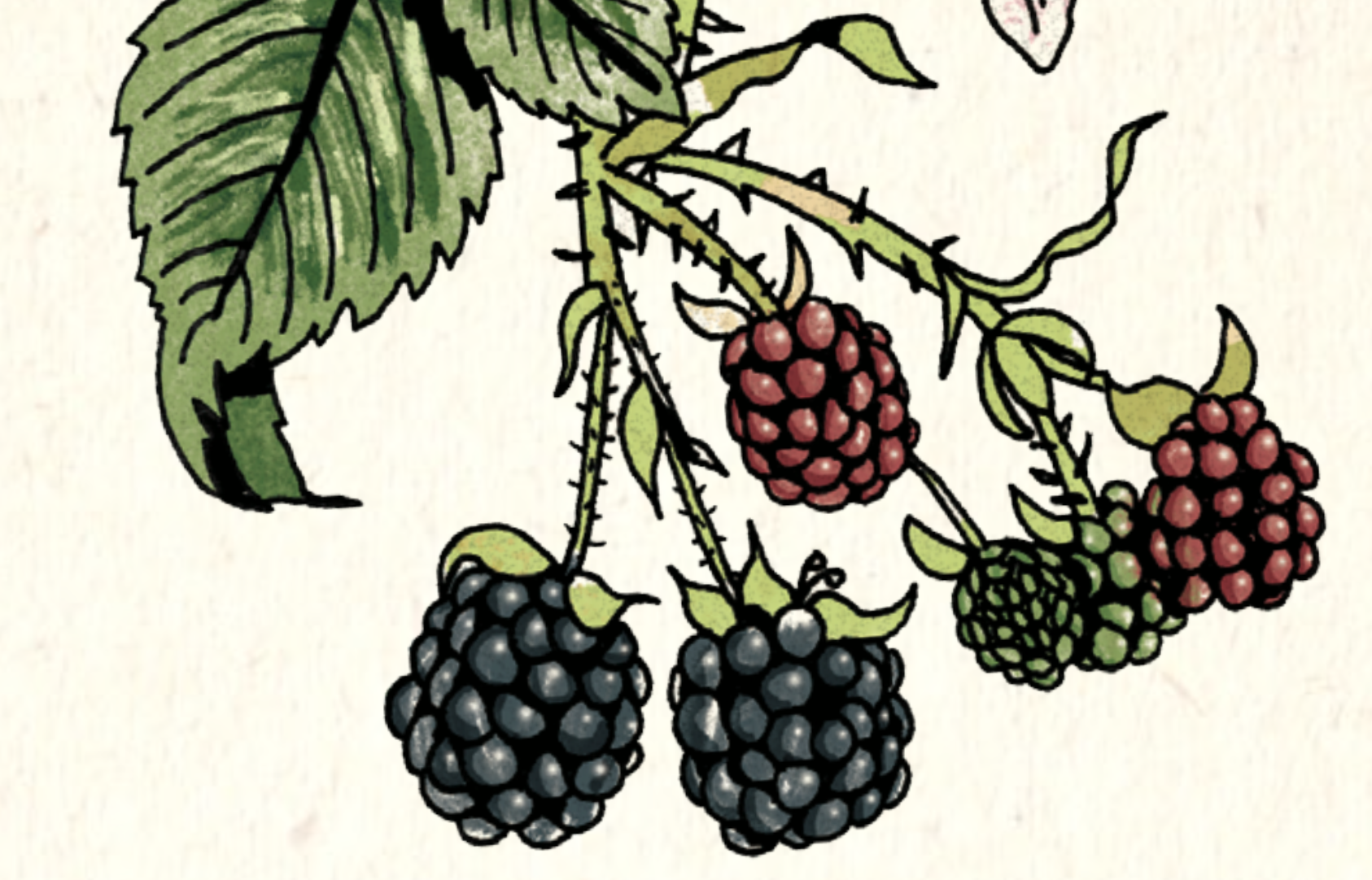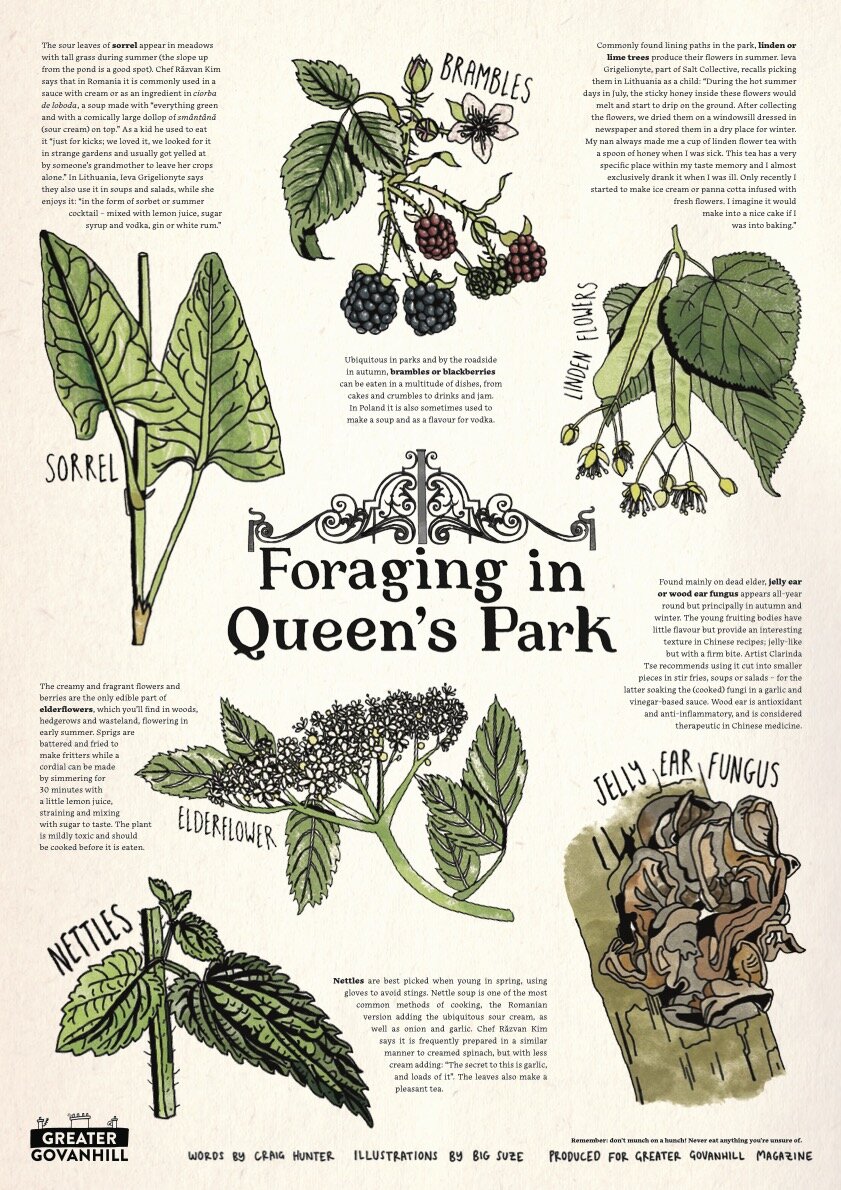Easy Pickings: the Joy of Foraging
You don’t have to travel far to find wild herbs, mushrooms and berries growing in our area. Craig Hunter details his experience foraging in the Southside and offers tips to those interested in getting involved.
Illustration: Big Suze
By Craig Hunter
It all started with the brambles.
Late summer was when jam supplies were restocked for the year ahead. I was issued with tupperware and sent forth on a mission from mum. Raspberries and blackcurrants might also make their way into the jelly sock, dripping in the kitchen. But it was blackberries, the most abundant berry in the west of Scotland, which took centre stage.
Taking care to avoid being jabbed by thorns or stung by nettles, the best finds are always the hardest to reach. Even then, a bountiful reserve is still retained by the dense bushes for the rest of the animal kingdom. Berries dropped when stretching across the defences are left as a tribute to the insects, rather than a cause for concern.
It is all very well to make desserts and jams from the haul, but it would be a crime not to eat some while picking. My loose rule is to eat all the ones that are a bit squidgy, oozing their purple dye over my fingers. I put the unbroken berries in the tub, otherwise it never gets filled. In order to balance the sharp and sweet tastes of individual brambles, a decent handful should be gorged on at once. Bliss.
You don’t have to travel too far from Govanhill to enjoy such riches. Queen’s Park has a healthy supply of brambles, while I’ve found raspberries in Pollokshields and blackcurrants on Langside Road. Herbs are widely available from streetside planters if you keep your eyes peeled. I’ve been getting dill, oregano, sage, rosemary and mint in this manner for years.
In spring, it is worth visiting Linn or Pollok Park, where wild garlic takes over whole swathes of ground, particularly near the river Cart. The smell is pervasive. Popular as a pesto, this milder form is also nice in salads and as a garlic substitute in most recipes. When it starts to dry up in May, garlic mustard pops up to replace it. Heading in the opposite direction, three-cornered leek can be found by River Clyde or Kelvin. This makes a fine alternative to spring onions and, like wild garlic, the whole plant can be eaten.
It’s not all about free food though. My forays into mushroom picking, for years tentative, accelerated dramatically during lockdown, and introduced me to whole new worlds at a time when my usual existence was on hiatus.
Fungi hold a unique place in our ecosystem, interconnecting our forests underground and popping up to spread their spores when the time is right. The huge variety of shapes and colours are a delight to spot, with an added bonus if it happens to be edible. This learning process is necessarily laborious, given the risks (I started out by learning the deadly lookalikes), but a deeper understanding of how weather, seasons and habitat interact is rewarding and addictive.
When foraging, it’s important to ensure our relationship with the environment is not destructive. Cut greens with scissors, and mushrooms with a knife – rather than yanking out of the ground; don’t take everything, or you may not see it next year; try to leave the surrounding area intact.
It is also important, of course, to make sure you have picked what you think you have (never munch on a hunch!). This is particularly true of mushrooms, but you wouldn’t want a daffodil leaf in among your wild garlic either. I have seen several edible varieties of mushroom in Queen’s Park, but also a few more dangerous ones which are not always obvious.
It is generally wise to avoid the sides of busy roads when foraging as the fumes get absorbed in berries, and you should maybe avoid dandelions in areas popular with dog walkers.
Other than that, take your time and enjoy the experience and, if you wouldn’t mind, leave some for me.
This fantastic poster was for our third print issue. If you would like a copy of your own, you can sign up to become a member of Greater Govanhill and request a copy of issue 3 here!

